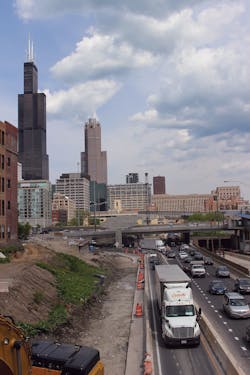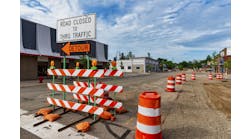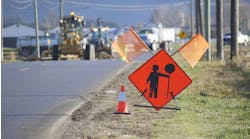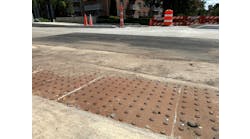Chicago natives are no strangers to traffic. Growing numbers of cars and trucks throughout the region have caused an increase in traffic delays, leading to excessive travel times and congestion. That’s why the Illinois Department of Transportation (IDOT) had to think boldly and reach deep in developing plans to address the challenges around what is arguably the hub of traffic for the entire Midwest, the Jane Byrne Interchange.
Formerly called the Circle Interchange, the Jane Byrne Interchange is located in the middle of Chicago, at the confluence of I-90/94 (called the Kennedy Expressway north of the Jane Byrne Interchange and the Dan Ryan Expressway to the south), I-290 (Eisenhower Expressway) to the west, and Congress Parkway to the east. With more than 400,000 vehicles traveling through the interchange daily and more than 900 crashes annually, it rates as one of the worst bottlenecks in the country. Originally built in the late 1950s and early 1960s, the existing configuration lacks modern geometric features. The existing pavement and structures are showing deterioration and are at the end of their design life. In 2012, IDOT began the process that will lead to a full reconstruction of the interchange.
Getting going
A few critical goals were established at the beginning. First and foremost, IDOT needed to develop a project that would improve safety and mobility through the interchange. Other priorities included allowing for future managed lane expansion and maintaining access to the local street network. Identifying project constraints was one of the first tasks completed—this project has no shortage of them. Being in a highly developed urbanized area, the availability of additional land for right-of-way needs is limited or simply does not exist. In addition, IDOT had to plan around other facilities that occupy space within the interchange itself. The Chicago Transit Authority’s Blue Line runs between the eastbound and westbound Eisenhower, actually going underground to get through the interchange. Below the CTA trains, there are several active and abandoned underground water tunnels that carry drinking water into and out of the Cermak drinking water pump station, located just south of Harrison Street between the northbound and southbound Dan Ryan.
Impacts to the surrounding neighborhood had to be minimized. The University of Illinois at Chicago campus, the Greektown and West Loop neighborhoods, the Illinois Medical District, and numerous residential buildings are all adjacent to the project. Impacts to each of these had to be identified and addressed. With all of these factors considered, geometric concepts were developed that will provide better traffic flow, increased capacity and reduced ramp conflict points. While settling on a reconstruction plan for the interchange was an enormous task, coming up with a plan to maintain mobility for all drivers throughout the duration of the project also was a big concern for IDOT. Keeping lanes open and minimizing impacts to motorists are priorities on every project IDOT undertakes, but even more so for The Byrne due to the high volume of traffic and the interchange’s overall importance to the region. More than 30 geometric concepts were evaluated during plan development, many of which were ultimately eliminated due to issues with constructability, mobility, right-of-way needs, and conflicts with utilities and other infrastructure in the area. The ultimate improvement selected includes full reconstruction of all the existing bridges and pavement, as well as a new two-lane directional flyover bridge to accommodate the heavy movement from the northbound Dan Ryan to the westbound Eisenhower.
Advance contracts were let to widen and replace five overhead crossing bridges. This work has been accomplished by utilizing shoulders for travel lanes and restricting lane reductions to the overnight hours when traffic is lighter. The two-lane ramp from the eastbound Eisenhower to the southbound Dan Ryan Expressway was reduced to a single lane to allow construction of the new Halsted Bridge while keeping the existing structure open to traffic. Additionally, the existing three-lane roadway between Congress Parkway and the Eisenhower was reduced to two lanes.
NB Dan Ryan traffic presently must go under Congress Parkway to meet the Eisenhower; soon, it will go over it.
Feeling the Byrne
The largest traffic impact to date has involved construction of the two-lane flyover bridge that will eventually replace the single lane, winding ramp in use today. The existing lane configuration on the northbound Dan Ryan provides five lanes of traffic feeding into the interchange, two of which split off to the Eisenhower and Congress Parkway. The ramp lane to the westbound Eisenhower goes under several cross streets, over the Kennedy, and under additional cross streets before finally joining the Eisenhower. The replacement flyover bridge will carry traffic smoothly over all the cross streets and highways. This required IDOT to close the existing ramp in order to build the new abutment, approach pavement and other substructure elements. In order to keep the existing movement open, the remaining mainline lanes were narrowed and moved onto the shoulder to make room for a fourth exit-only lane on temporary pavement. The northbound-to-eastbound movement could not be maintained. (That ramp was removed from service and will be replaced in a future contract.)
The new traffic configuration reduced the five-lane Dan Ryan to four lanes. With an average daily traffic count of more than 180,000 vehicles per day, the impacts from a standard lane closure were deemed intolerable. A strategy was implemented that shifted some of the traffic impact off of the Dan Ryan. I-55, or the Stevenson Expressway, enters downtown Chicago from the southwest. A two-lane ramp connects both directions of the Stevenson with the Dan Ryan just south of the Jane Byrne Interchange. By merging two lanes of ramp traffic into a single lane, the second Stevenson ramp lane was utilized to maintain traffic flow on the Dan Ryan approaching the interchange. These ramps carry approximately 35,000 vehicles per day. As a result, the impacts being experienced are less severe than a standard lane closure on the Dan Ryan.
Another significant traffic impact was anticipated for the girder erection of the new flyover bridge. The new bridge is a 13-span, six-unit structure that is nearly 2,000 ft long. As with other flyover bridges, the curved alignment and large spans lead to tall and long girder segments that can be difficult to erect. The largest segments span parts of the Kennedy, Dan Ryan and Eisenhower expressways. The unit in question (unit 4) is composed of six girder lines, each 90 in. tall and delivered in 129-ft segments. The unit is a two-span structure, with each span 189 ft long. Several brainstorming meetings and planning sessions were held with designers and IDOT senior staff to discuss the constructability of this unit. Ideas discussed to deliver the beams and get them in place included building crossovers, tower cranes and runarounds.
Eventually, a plan was settled to complete the job by closing lanes and parts of the expressways during select hours that presented the least impact to traffic. For the two largest spans, the contractor would be permitted to completely close the Eisenhower entering downtown Chicago between 10 p.m. on a Friday and 4 a.m. on a Monday. The extended closure provided a staging area for the contractor to deliver and prepare the girders and mobilize equipment. A separate closure would be permitted on the Kennedy entering downtown Chicago between 10 p.m. on a Saturday and 8 a.m. on a Sunday for the actual girder erection. A 28-day closure of the ramp linking the inbound Kennedy to Congress Parkway entering downtown Chicago was permitted to establish a storage area.
Once the contract was awarded, IDOT worked with the contractor and steel erector to develop an alternate strategy that would lessen traffic impacts even further and still allow girder erection to be safely completed. The proposal consisted of spreading the beam erections over four weekends, with two weekends set aside for setting the two major spans. For the first two weekends, both directions of the Eisenhower would be closed between 10 p.m. Friday and 5 a.m. Monday. In addition to those closures, both directions of the Kennedy would be restricted to one lane between 8 p.m. Saturday and 10 a.m. Sunday morning, with intermittent closures of all lanes between 10 p.m. Saturday and 8 a.m. Sunday while the girders were placed. The final two weekends followed the same timeline, but impacts were limited to the outbound Eisenhower and inbound Kennedy.
The surrounding local streets were used to establish the preferred alternate routes and detours, including a temporary Texas Turnaround at the Ashland Avenue interchange just west of the Byrne.
The public element
This plan could only be a success if the public was well-informed and strongly advised to avoid the work zone and seek alternate means of traveling in and out of Chicago during the impacted weekends. A robust public information campaign was launched to inform motorists of the upcoming work. Two separate incident management meetings were scheduled with area stakeholders to notify them of the upcoming work. A separate emergency responder meeting was held with the Chicago Office of Emergency Management and Communication, Illinois State Police, Chicago Fire and Police departments, as well as IDOT’s Emergency Traffic Patrol, to establish emergency response routes and special assignments during the weekends of construction. Over a dozen changeable message signs were placed throughout the region and as far away as the Indiana and Wisconsin borders to advise motorists of the work. Numerous press events were held in and around the site with area media outlets.
Getting the work scheduled posed an additional problem. Chicago is a busy place to be in the summer months, with major events almost every weekend. Sixteen separate major events and eight home games for the Chicago Bears immediately excluded several weekends for which work could be scheduled. Working with Chicago officials, IDOT was able to identify seven potential weekends between August and November 2015 when the work could take place. Weather cooperated, and the first four eligible dates selected were used according to plan.
Extensive resources were dedicated to traffic management and outreach during the closures. The Chicago Department of Transportation dispatched several Traffic Management Aides along the detour routes and adjacent streets to keep vehicles moving and offer assistance. The Illinois State Police had up to six troopers dedicated to enforcement, providing assistance as needed. The Emergency Traffic Patrol for IDOT had 13 tow truck drivers and three supervisors patrolling regular routes each of the weekends. An additional three drivers and a supervisor were dedicated to the Jane Byrne work. The Chicago Office of Emergency Management and Communication’s dispatch center was staffed with IDOT personnel for the duration of the closures, with status updates distributed to all stakeholders every two hours.
Other than getting off to a slow start the first weekend, everything proceeded according to plan. Due to the extensive planning, outreach and coordination done well before the closures took place, all of the girders that were supposed to be installed were put in place without any major incidents.
Work is continuing on the Jane Byrne Interchange until at least 2020, with a focus on completing the cross street bridges, the outbound Eisenhower and the flyover from the Dan Ryan to the Eisenhower.
The meticulous planning and constant communication that has taken place with all of the parties involved and affected by the Jane Byrne Interchange reconstruction has paid off numerous times during the life of this project. The lessons learned about traffic management during the course of this project have been invaluable for IDOT and certainly will be applied in the future.



